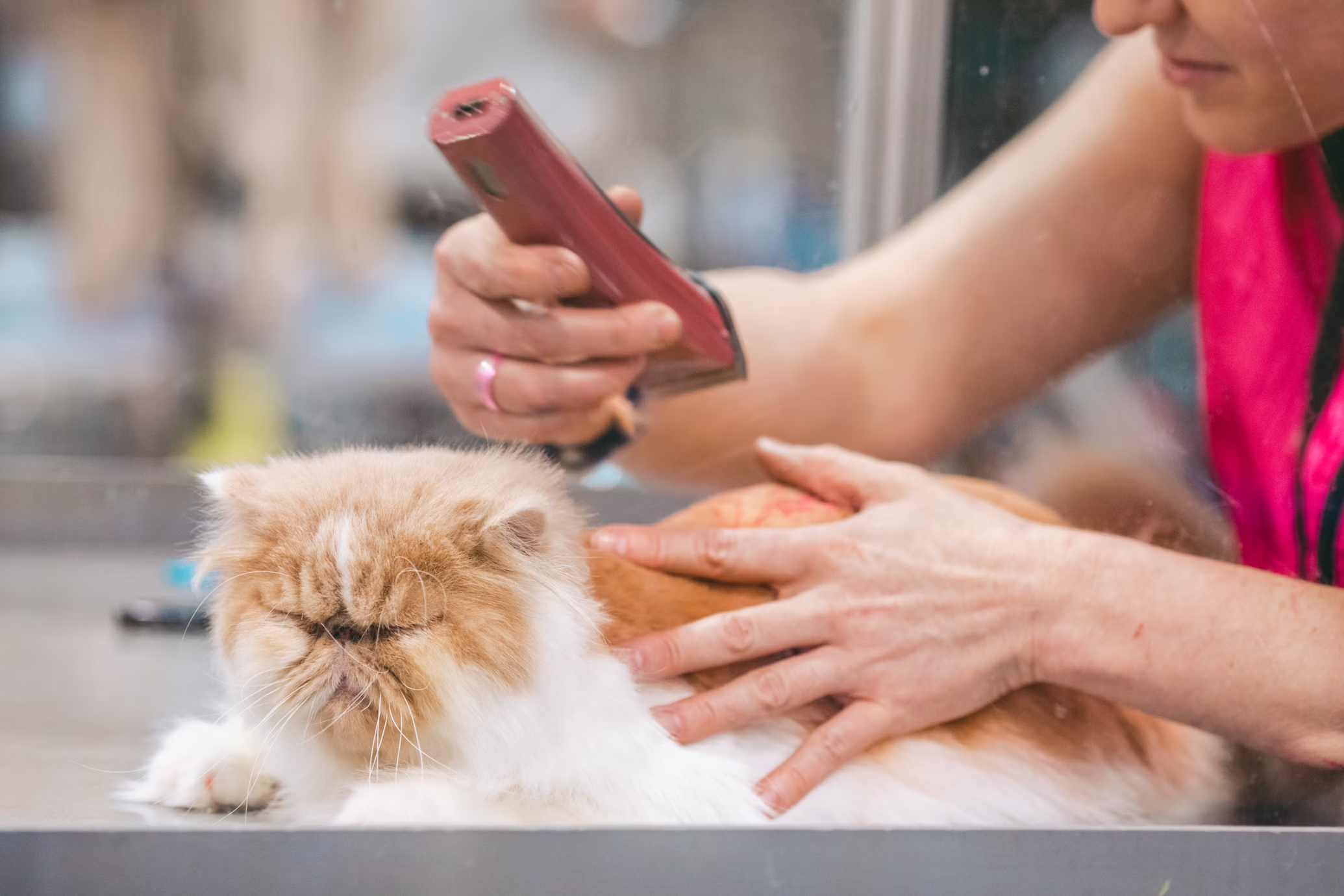
Grooming your cat is an essential part of pet care that ensures their health, happiness, and well-being. Understanding your cat’s specific needs based on their breed and upbringing is crucial for effective grooming. For instance, Persian cats with their long, luxurious coats require more frequent brushing compared to short-haired breeds like American Shorthairs. Additionally, a cat’s background, such as being a rescue or a kitten raised in a nurturing environment, can influence their comfort level with grooming. Recognizing these differences will help tailor your grooming routine to meet your cat’s unique needs.
Here is a video showing how a cat groomer grooms her cats:
Why Grooming Your Cat is Important
Health Benefits
Grooming helps in detecting early signs of health issues such as:
- Skin Problems: Regular grooming can help you spot skin infections, fleas, ticks, and other parasites early.
- Obesity: Grooming sessions allow you to monitor your cat’s weight and body condition.
- Dental Health: While grooming, you can check for any signs of dental issues like tartar buildup or gum disease.
Reducing Shedding and Hairballs
According to the Bond Vet, regular grooming can reduce shedding and the formation of hairballs. Hairballs are not only unpleasant for you to clean up but can also cause digestive issues for your cat.
Essential Tools for Grooming
Before you start grooming your cat, it’s important to have the right tools on hand. Here are some essentials:
Brushes and Combs
- Bristle Brush: Ideal for short-haired cats.
- Slicker Brush: Good for removing loose fur and preventing matting.
- Metal Comb: Useful for detangling and checking for fleas.
Need a cat grooming brush/comb in Singapore? Browse our selection of goods that have been carefully curated with love and care here.
Nail Clippers
Invest in cat-specific nail clippers or grinders to safely trim your cat’s nails.
Shampoo and Conditioner
Use cat-specific shampoo and conditioner to avoid skin irritation. Never use human shampoo on your cat.
Toothbrush and Toothpaste
Cat-specific toothbrushes and toothpaste help maintain dental health.
Step-by-Step Guide to Grooming Your Cat
1. Brushing Your Cat
Frequency: Brush short-haired cats once a week and long-haired cats every other day.
- Choose the Right Brush: Use a bristle brush for short-haired cats and a slicker brush for long-haired breeds.
- Start Slowly: Begin by gently brushing in the direction of the fur growth.
- Check for Tangles and Mats: Use a metal comb to gently detangle any knots. Be extra careful around sensitive areas like the belly and tail.
- Reward Your Cat: Offer treats and praise to create a positive association with grooming.
2. Bathing Your Cat
Frequency: Bathing is not usually necessary for most cats, but long-haired breeds or cats with skin conditions may need occasional baths.
- Prepare the Bath Area: Use a sink or a small tub with a non-slip mat. Fill it with a few inches of lukewarm water.
- Use Cat-Specific Shampoo: Apply shampoo gently and avoid the head area. Rinse thoroughly to remove all soap residue.
- Drying Your Cat: Use a towel to pat your cat dry. For long-haired cats, you can use a hairdryer on a low, cool setting if your cat tolerates it.
3. Trimming Nails
Frequency: Trim your cat’s nails every 2-3 weeks.
- Get Your Cat Comfortable: Hold your cat securely and gently press the paw to extend the claws.
- Trim the Tips: Clip only the sharp tips of the nails, avoiding the quick (the pink part of the nail).
- Reward and Praise: Give treats and affection to reward your cat.
4. Cleaning Ears and Eyes
Frequency: Check your cat’s ears and eyes weekly.
- Ear Cleaning: Use a vet-recommended ear cleaner and cotton balls. Never use cotton swabs as they can damage the ear canal.
- Eye Cleaning: Use a damp cloth or pet-safe wipes to gently clean around the eyes.
5. Dental Care
Frequency: Brush your cat’s teeth daily if possible, or at least a few times a week.
- Choose Cat-Specific Products: Use a toothbrush and toothpaste designed for cats.
- Start Gradually: Let your cat get used to the taste of the toothpaste first, then gradually introduce the toothbrush.
- Brush Gently: Focus on the outer surfaces of the teeth and gums.
Additional Tips for Successful Grooming
- Start Young: Begin grooming your cat when they are a kitten to get them accustomed to the process.
- Be Patient: Take breaks if your cat becomes stressed or agitated.
- Use Positive Reinforcement: Always reward your cat with treats and praise after grooming.
Common Grooming Challenges and Solutions
Shedding
Solution: Regular brushing and a healthy diet can help reduce shedding. Use a shedding blade or a grooming glove for effective fur removal.
Mats and Tangles
Solution: For severe mats, consider using a detangling spray or consulting a professional groomer. Regular brushing prevents mats from forming.
Stress and Anxiety
Solution: Create a calm grooming environment and use pheromone sprays to reduce anxiety. Gradually increase the duration of grooming sessions.
If you have any other queries or issues, click here for a list of veterinary and other pet services in Singapore.
Conclusion
Grooming your cat is more than just maintaining their appearance; it’s an essential aspect of their overall health and well-being. By incorporating regular grooming into your routine, you can prevent health issues, reduce shedding, and strengthen your bond with your furry friend. Remember to be patient and gentle, and always reward your cat for their cooperation.
For more detailed guides and product recommendations, check out these resources:































